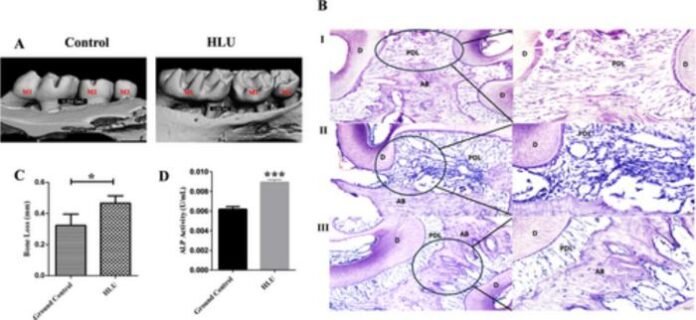Extended periods in space can lead to all kinds of health problems. The hazard posed by radiation is well known and is the reason NASA and other space agencies impose limits on the amount astronauts are exposed to. There’s also microgravity, which has been studied extensively thanks to regular missions to the International Space Station and long-term studies (like the NASA Twins Study). According to this research, extended periods in microgravity will result in muscle atrophy, bone density loss, changes in eyesight, effects on the cardiovascular and endocrine systems, and even genetic changes.
However, according to new research, spending a lot of time in space might pose another health hazard: periodontitis, a serious and common condition where the gums become inflamed and the bone that supports teeth starts to break down. In a recent study by researchers from the University of Sharjah in the United Arab Emirates (UAE), it was determined that astronauts have a higher chance of developing periodontitis and losing teeth. This research could lead to additional health protocols for astronauts, as well as new mitigation measures performed aboard future space stations and long-duration space missions.
The study was led by Zahi Badran, a professor of periodontology at the University of Sharjah’s College of Dental Medicine. He was joined by colleagues from the college’s Research Institute for Medical and Health Sciences, Clinical Health Sciences Department, and Basic Medical Sciences Department, and the National Institute of Health and Medical Research (INSERM) at the University of Nantes. The paper that shares their research and findings appeared in the Journal of Periodontal Research.
 European Space Agency astronaut Samantha Cristoforetti works with the Microgravity Science Glovebox aboard the International Space Station in 2014. Credits: NASA
European Space Agency astronaut Samantha Cristoforetti works with the Microgravity Science Glovebox aboard the International Space Station in 2014. Credits: NASA
As the authors note, the effects of microgravity on human health have become a major focal point of research in anticipation of future missions to the Moon, Mars, and long-duration stays in Cislunar space. However, one area that is not well-understood is the effects microgravity can have on oral health and gum diseases like periodontitis.
To measure the potential impact long-term spaceflight and time in microgravity can have, the researchers conducted laboratory experiments involving mice and a special model that simulates microgravity. The mice were divided into two groups, where one was subjected to simulated microgravity while the second (the control group) remained in Earth-like gravity.
Microgravity was simulated using “hindlimb unloading,” a method where the hindlimbs of an animal are elevated to prevent weight-bearing while the forelimbs remain weight-bearing. This mimics the headward fluid shift observed during spaceflight, including arterial and venous blood flow and cerebrospinal fluid. Gum disease was then introduced to both groups via ligature-induced periodontitis, where a small thread or wire is placed around a tooth to accumulate plaque and inflammation, ultimately leading to bone loss. The researchers used Alkaline Phosphatase (ALP) activity as a marker for bone growth, liver function, and other biological processes.
According to their findings, the control group showed minimal bone loss while the group in simulated microgravity showed significant bone resorption — i.e., bone breaking down and being reabsorbed by the bloodstream. As Badran explained:
[The study] found that mice exposed to simulated microgravity showed much worse gum inflammation and bone loss compared to mice with induced periodontitis on the ground. They had higher levels of disease markers, more severe tissue damage, and more immune cells in the affected areas. [They also] displayed a significant increase in ALP activity compared to the control group, indicating increased bone resorption and inflammation associated with periodontitis due to the change in gravity. It also opens the door to better understanding how inflammation works in the body, both in space and on Earth.
This research underscores the importance of developing proper care strategies for future crewed space missions, including tailored measures to prevent inflammation and gum disease. According to the team, this study is the first of its kind and they hope that it will help pave the way for additional multidisciplinary research on oral health and disease in microgravity, eventually leading to breakthroughs in space medicine. Looking ahead, they will attempt to replicate their model to account for additional microbiological and immunological parameters to determine the connection between gum diseases and other systemic diseases in microgravity. Said Badran:
[The study] calls for the integration of dental medicine, particularly periodontology, into astronauts’ and future space colony inhabitants’ health protocols. Specialized prevention and treatment strategies, along with in-mission monitoring tools, most probably will be essential in case of prolonged space stays. Simultaneously, the model offers terrestrial benefits, providing insights into the periodontal status of immobilized, bedridden patients, who experience similar effects of microgravity. This model will be extensively studied to better understand the biological pathways underlying these outcomes and to explore how periodontitis may influence other systemic diseases under microgravity.
Further Reading: EurekAlert!


